Wet bubble or Mycogone contamination: how to identify, prevent and treat it
What is wet bubble disease
This is a fungal disease caused by parasitic pathogen Mycogone perniciosa, that usually affected pinheads and mushroom fruitbody. It has a few often used names: mycogone, wet bubble, white mushroom mold, vesicular disease, La Mole.
It is one the most common problems of commercially cultivated edible mushrooms. Usually we can find many examples of mycogone contamination from Agaricus bisporus mushroom farmers. Although wet bubble affected magic mushrooms, i.g. Psilocybe Cubensis quite often.
Mycogone perniciosa not known to be pathogenic to people or animals!
Let's figure out mycogone contamination in magic mushrooms cultivation, mostly for Cubensis.
Symptoms of wet bubble contamination
The early stage of Mycogone perniciosa is characterized by the development of dense white fluffy mycelial growth or wart-like growths, that usually appear on pinheads and mushroom fruiting bodies.
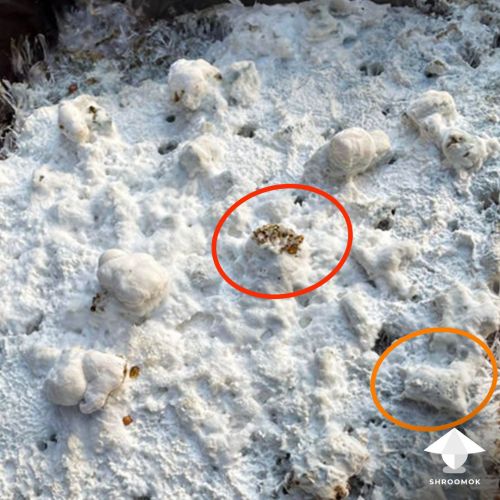
On the later stage of Mycogone contamination you can admit deformations, distorted masses of mushroom tissues, or puffy blobs instead of normal pinheads and mushrooms. As a result, the primordia and mushrooms cannot develop normally.
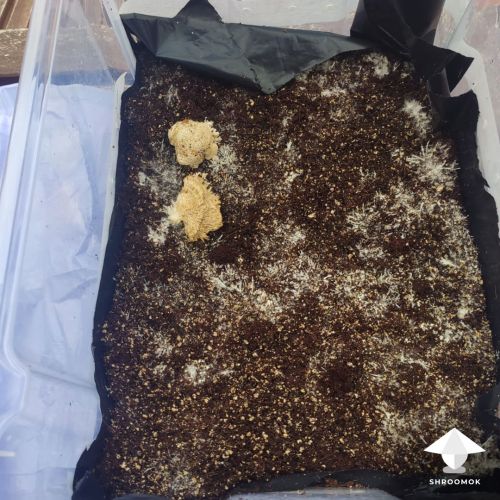
The shapeless mass is initially white and loose, but over time it turns brown and begins to decay.
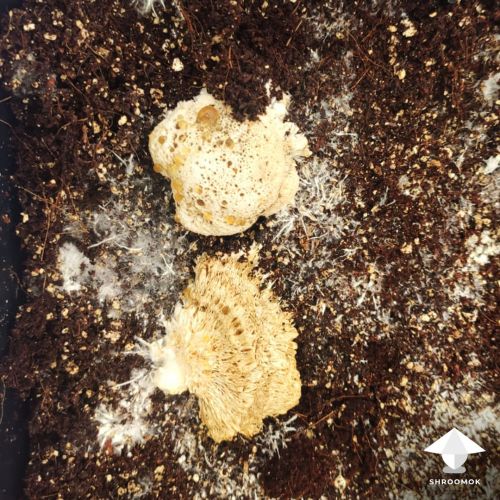
On the late stage of wet bubble an amber liquid – yellowish, orange, brown – oozes from pins, blobs and mycelium clots.
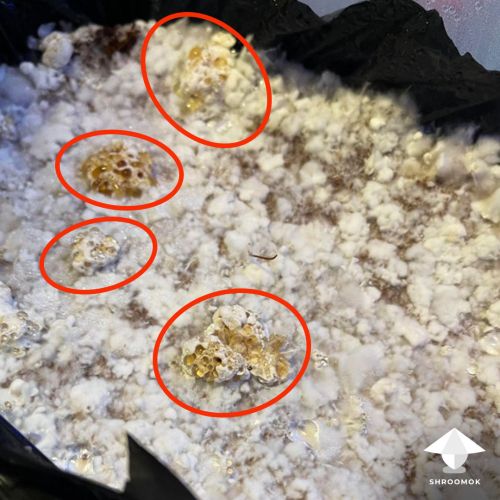
This fluid contains spores and bacteria that spread throughout the mushroom cake and are accompanied by an unpleasant rotten smell. However, this smell is not noticeable if the contamination is minor.
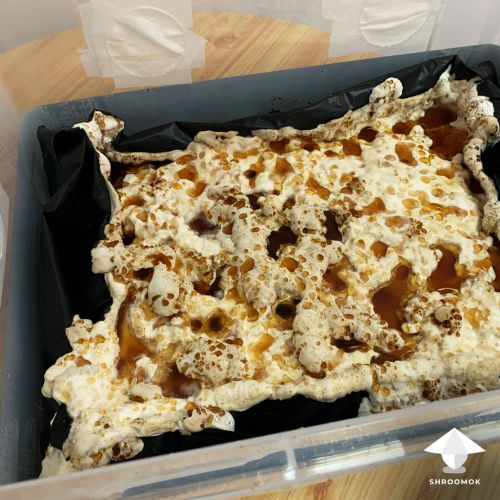
In dry conditions, the shapeless masses remain dry in appearance and similar to Verticillium contamination aka Dry Bubble disease. More about it here: Dry Bubble disease
How to recognize whether it's mycogone contamination or mycelium piss
Wet bubble contamination seems similar to mycelium metabolites, but Mycogone has some differences.
Mycogone usually appears on pinheads and mushrooms. It creates a blob with porous surface, like a sponge or coral-like indentations. Look, each yellow-brown drop has its place. Usually this liquid is slimy and smelly.
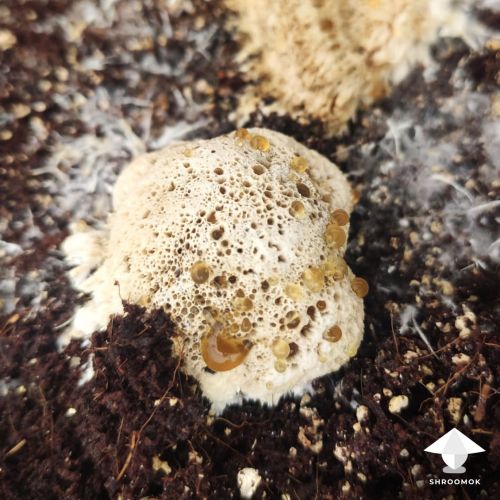
Damages caused by Mycogone resemble coral-like indentations on the surface of bubbles.
While mycelium piss – aka mycelium metabolites – don't have any dents, transparent, without any odor at all, watery and without slime, but with yellow-brown color.
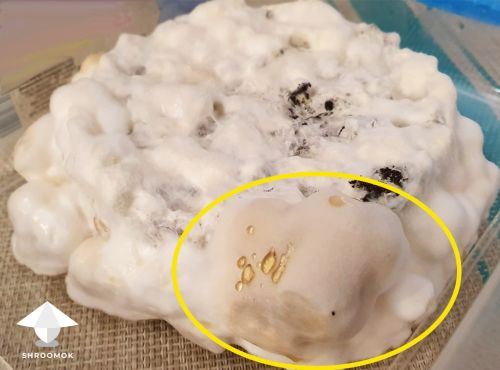
Mycelium piss can be a sign of fighting with mild contamination or stress, but it's not a contamination itself and totally safe.
More examples here: Mycelium metabolites or mushroom piss
Main causes of mycogone contamination
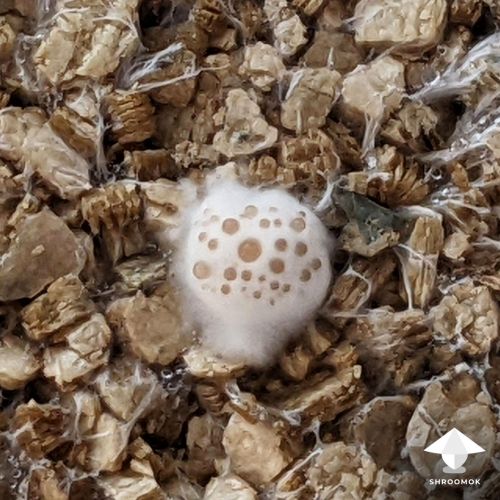
Mycogone perniciosa forms two kinds of spores:
Conidiospores — unicellular, thin-walled spores, with a relatively short life. Very light, therefore, they can be carried by air currents.
Chlamydospores — consist of two cells, thick-walled, brown spores. They stay viable for several years.
The main Mycogone habitat is soil, that's why the main source of contamination is mostly the bulk and casing substrates.
The disease can be spread by spores and pieces of mycogone mycelium that stick to any object that comes into contact with the pathogen — air flow, dust, tools, flies and mites, grower's hands and clothes.
The incubation period of Mycogone is two weeks.
What does it mean? If Mycogone appears during the first flush, its spores were probably introduced with the bulk or casing substrate during spawn to bulk step or applying casing layer. Later contamination – more than 2 weeks after spawn to bulk and casing, on the 2-3 flush – are more probably spread by air, grower's hand and clothes, tools, insects etc.
Preventive measures of wet bubble disease
Substrate pasteurization or sterilization and sanitation routine overall is a key!
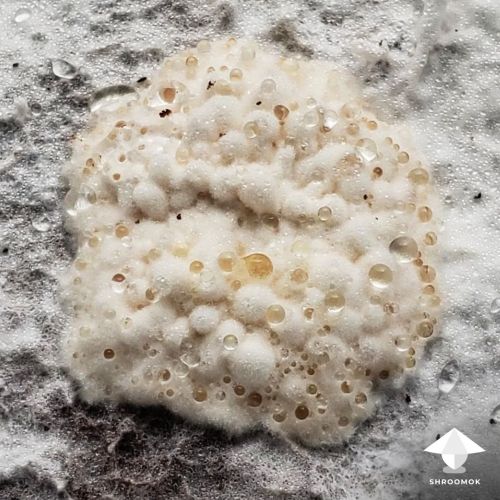
Bulk and casing substrate pasteurization in pot or bucket. Spores of Mycogone perniciosa are killed at 120°F or +49°C and higher when exposed to moist heat. Usually you add hot boiling water 212°F or 100°C and let it sit for a few hours and cool down slowly. This treatment is enough for Mycogone prevention.
Bulk and casing substrate pausterization in the oven also works great. There should be at least 160°F or +70°C inside the substrate for one hour. Set your oven at 400°F or 200°C for 1 hour and let the substrate cool down in the oven slowly.
Sterilized substrate. Use pressure cooker or autoclave at 250°F or 121°C (15 psi) for one hour. Although pasteurization is preferable for bulk and casing.
Good fresh air exchange (FAE) in fruiting chamber. Stagnant air causes a wide range of contaminants.
Lowering temperature. Mycogone doesn't grow at temperatures lower than 60°F or 15°C. For many edible mushroom species it's a good point, however not for warm-loving magic mushroom species.
Strict sterility and sanitation conditions before and during any mycological procedures. Use sterile tools, wipe surfaces with isopropyl alcohol, wash your hands, wear gloves and a mask.
Wet bubble treatment
Mycogone is quite strong and resilient contaminant. It is more effective to prevent the appearance of this pathogen than to treat it.
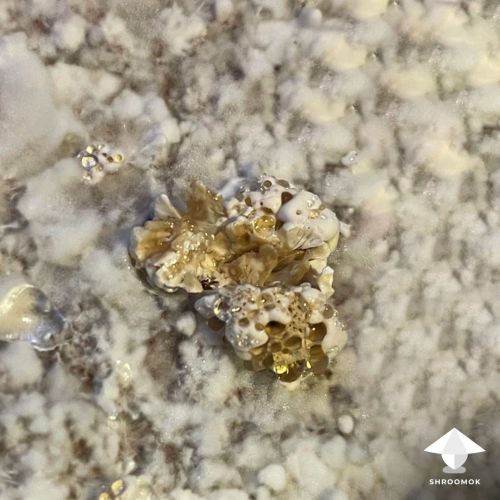
Small mushroom cakes or mushroom blocks in monotub usually have not so big surface as mushroom bed on the farms. If you have Mycogone on top layer probably the entire bulk substrate and/or casing layer is contaminated with Mycogone spores — you can’t just scoop it out. It means Mycogone can appear again and again...That's why the most effective and popular advises here are: toss it immediately, bury in the backyard or burn it!
Small mushroom cakes or mushroom blocks in monotub usually do not have as much surface area as mushroom beds on farms. If the Wet Bubble is on the top layer, it is likely that the entire substrate is contaminated with Mycogone spores. You can’t just scoop it out. Mycogone can appear again and again... Therefore, the most effective and popular advice is: throw it away immediately or bury outdoors.
However, treatment is possible. Let's take a look at the experience of mushroom farmers. Do they really toss and burn mushroom blocks/beds with infected area size of a coin?
1) Salt or baking soda or ground lime application – the most common and safe method used by mushroom farmers for Mycogone treatment.
Carefully remove the Wet Bubble fragments using a disposable glove or plastic bag. Once you have placed them in the bag or glove, carefully turn them inside out, seal them tightly, and discard.
Then the affected area should be:
a) sprinkled with salt, or baking soda or ground lime
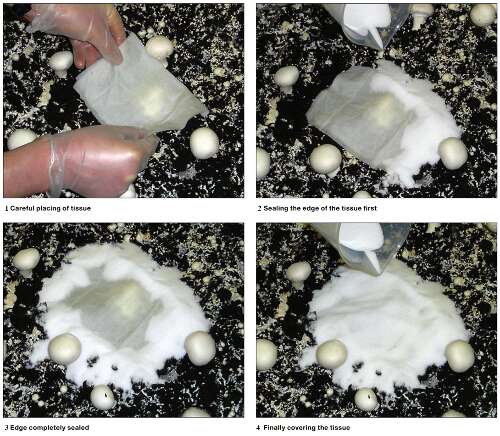
b) or watered with a formalin (formaldehyde) solution and then strewed with ground lime. These treated areas can be completely removed the next day, grasping the casing layer of a larger diameter.
Don't mist, spray, rehydrate mushroom cake until you have treated the contaminated area to avoid spreading the contamination throughout the top layer!
In literature the following recommendations for Mycogone prevention and treatment are given:
2) According to Kneebone (1961) he recommends the use of chlorinated water (150-250 ppm) for misting/watering to prevent Mycogone spores germination. This is also a safe prevention and treatment method for Mycogone.
How to prepare 150-250 ppm Chlorinated Water?
Dissolve the bleach (Sodium Hypochlorite - NaOCl) in 1 Qt/Liter of water according to these ratios:
NaOCl 5.25% (Amazon) - add 3.0-5.0 ml per 1L of water
NaOCl 6.0% (Amazon) - add 2.6-4.4 ml per 1L of water
NaOCl 7.5% (Amazon) - add 2.1-3.5 ml per 1L of water
NaOCl 12.5% (Amazon) - add 1.3-2.1 ml per 1L of water
Fill a spray bottle with the chlorinated water solution and spray it on the top surface of the cake.
3) A spray of Benomyl 0,1% (also marketed as Benlate) fungicide immediately after casing has been found one of the most effective (Gupta et al., 2018).
4) Application of fungicides: Carbendazim, Chlorothalonil, Prochloraz Manganese complex (Sportak 50 WP) 0,1% into casing material (Gupta et al., 2018).
5) A spray of 0,8% Formalin (formaldehyde) on casing surface, immediately after its application is also effective (Gupta et al., 2018).
Afterword
More photo examples of Dry Bubble in Wet Bubble (Mycogone) photo gallery
If you find this guide helpful support me on buymeacoffee
Feel free to ask your questions and get help for free on Forum, or on Discord and Reddit, or in comments to this post ⬇️
You can also request a Personal Consultation with Shroomok.
Have a happy growing and healthy shrooms!


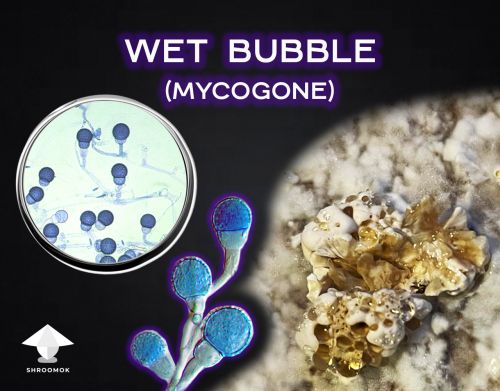
Comments
The three floating buttons (share, toc, comment) are really distracting on mobile. They make looking at pictures difficult.
@Nemo
I agree with you, now these buttons invisible on mob
thanks for feedback, I appreciate it
Add comment